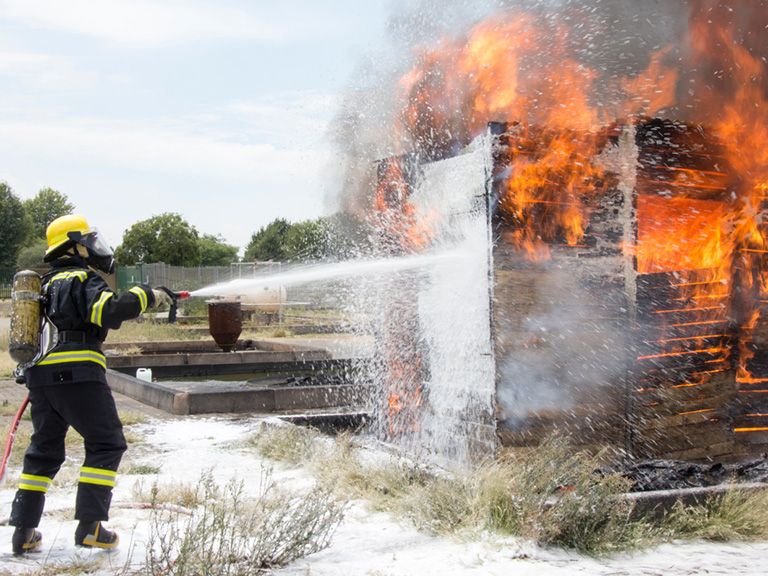Mrs Kumble had insured her flat along with household goods under Standard Fire Policy and unfortunately there were 3 occasions when she had to make 3 different claims during the policy and all these claims were settled to her satisfaction. When she went to Insurance Company for renewal of policy, it was denied because of her claim history. So, there was an issue of non-renewal of Policy.
Dr. Venkatraman had insured his clinic along with medical equipment under Fire Policy for Rs 2 Crs. and it was totally damaged in fire, but his claim was settled for Rs 1.4 Crs. and on enquiring he was told that it was due to Underinsurance – something not known /explained to him before claim. Thus, there was a dispute on account of reduction of claim amount due to Under- Insurance.
Ms Kulkarni’s owned a Beauty Parlour and was insured under Fire Policy. There was a short circuit in AC and resulting Fire damaged some of Furniture and equipment but there arose some dispute with regard to cause and quantum of claim. She intended to make complaint against Insurance Company and Surveyor. She did not know where to go and how to make a complaint. Hence there was an issue of redressal of grievance.
Then, there are cases the where the insured die during pendency of claim and insurance company insist for submission of Legal Heir Certificate for payment of the claim.
In the backdrop of above let us analyse the recent initiatives of IRDAI in the de-tariffed regime.
The Standard Fire and Special Perils Policy (SFSP) – an insurance contract that safeguards the insured against unforeseen contingency caused by accidental fire and allied perils was a part of All India Fire Tariff 2001. It offered protection from home risk to various other types of industrial risks including Godowns, warehouses and storage tanks etc.
The IRDAI began the process of ‘de-tariffing’ and bringing the various aspects of the Fire and Allied Perils segment of the general insurance business out of the ambit of the All-India Fire Tariff (AIFT) 2001 in 2006-07. It removed the pricing aspect of products with effect from 1st January 2008. Pricing was then left to the insurers subject to the Product Filing Guidelines issued by the Authority. These Guidelines stipulated that for all other aspects (other than pricing), namely the policy terms and conditions, clauses and General Regulations etc., the general insurance industry shall continue to be guided by the erstwhile AIFT, 2001 until further notice.
Recently, the IRDAI decided to complete the process of de-tariffing for the risks of Dwellings and Micro level and small level enterprises with effect from 1st April 2021 and these risks were de-notified from AIFT 2001 and replaced by relevant Guidelines.
Accordingly, the Authority issued guidelines whereby the Standard Fire and Special Perils (SFSP) Policy provided for in the erstwhile AIFT 2001 was replaced by the following standard products which shall be mandatorily offered by all General Insurers carrying on Fire and allied perils insurance business with effect from 1st April 2021.
- Bharat Griha Raksha (meant for Home Building and Home Contents)
- Bharat Sookshma Udyam Suraksha (meant for enterprises where the total value at risk is up to Rs. 5 Crores
- Bharat Laghu Udyam Suraksha (meant for enterprises where the total value at risk is more than Rs. 5 Crores and up to Rs. 50 crores)
The new policies have all been designed with policyholder friendly features and are worded in simple language for the convenience of the general public. The risks other than Home Building and Home Contents where value at risk exceeds Rs 50 Crs shall however continue to be governed by existing provisions of AIFT 2001.
The salient features of newly introduced policies are as under:
Bharat Griha Raksha
- Coverage – Home Building and/or Home Contents in India
- Sum Insured – No limit. The sum insured for Building is calculated considering the carpet area and the cost of construction. The sum insured for contents will be the cost of replacement of the contents.
- In built covers – Available for general contents like furniture and fittings, electronics, etc. equal to 20% of the Sum Insured of the Building Cover subject to a maximum of Rs. 10 lakhs. Higher Sum Insured can be opted for on payment of additional premium.
- – Annual Policy
- Long term Policy– Available up to 10 years
- Automatic increase in Sum insured– For long-term policy, the Sum Insured for Building shall auto escalate @10% per annum for a maximum of 100% of the Sum Insured at the Policy Commencement Date without additional premium. e.g., a Sum Insured of 20 Lakh at policy inception shall escalate to Rs. 22 Lakh by 1st policy anniversary, Rs. 24Lakhs by 2nd policy anniversary, ₹26 Lakh by 3rd policy anniversary and so on, with the maximum being ₹40 Lakh without additional premium. For Annual Policy, the Sum Insured shall be automatically increased each day by an amount representing 1/365th of 10% of Sum Insured at the Policy Commencement Date.
- Additional coverage beyond standard fire and special perils like Fire, Lightning, STFI, Malicious Damage, etc. – also covers in-built perils like Earthquake, Terrorism risks.
- In-built covers available– for Loss of Rent and Rent for Alternative Accommodation, Removal of Debris and Architect’s, Surveyor’s fees.
- Optional covers – Personal accident cover of Rs.5 lacs each for insured and spouse available. Not available for other family members.
- Valuable contents – Valuable Contents, like jewellery, silverware, paintings, works of art, valuable carpets, antique items, curios, paintings can be covered by opting for Optional Cover on Agreed Value Basis
- Underinsurance – Not applicable. For instance, area of a house is 100 sq.m. and cost of construction is Rs 2000 per sq.m. policy has been taken for Rs 15 lacs (instead of Rs 20 lacs) and there is repair claim of Rs 5 lacs, then full amount of Rs 5 lacs will be paid. Similarly, if household goods such as fridge, television, washing machine) have been insured for Rs.50,000, whereas the actual value is Rs.1 lakh, the policy will still pay the entire sum insured (Rs.50,000). insured any of your general home contents.
- Excess – Not applicable
Bharat Sookshma Udyam & Suraksha Bharat Laghu Udyam Suraksha:
- Coverage– Offices, Hotels, Shops, Industrial/Manufacturing risks, Utilities located outside Industrial/Manufacturing risks, Storage risks and Tank farms/Gas holders etc. in India
- Sum Insured– The total ‘value at risk’ under Bharat Sookshma Udyam should not exceed Rs. 5 Crores in respect of all insurable asset classes at any one location at the commencement of the insurance. However, risks beyond Rs 5 Crs and up to Rs 50 Crs will be covered under Bharat Laghu Udyam Suraksha Policy.
- Basis of sum insured – All Building/ Structure, Plant & Machinery, Furniture & Fixtures shall be insured on Reinstatement Value/Replacement Value basis. Stocks of raw material shall be covered on Landed Cost. Stocks in process shall be covered at Input Cost. Finished goods shall be insured for the Manufacturing Cost
- – Annual Policy. Long term policy not available.
- – Available for Curios, Works of Art, Manuscripts, Obsolete machinery etc.
- Increase/ Decrease in Sum Insured during policy period-– The sum insured can be decreased or increased on payment of additional premium.
- Increase in sum insured limits of the inbuilt covers like Additions, alterations or extensions, Temporary removal of stocks – The sum insured limits for these inbuilt covers cannot be changed.
- Risks covered– Policy covers in-built perils like Earthquake, Terrorism, Forest Fire, theft within 7 days of occurrence of insured event in addition to the standard fire and special perils like Fire, Lightning, STFI, Malicious Damage, etc.
- In-built covers available– Additions, alterations or extensions, Temporary removal of stocks, Cover for specific contents, Start-up expenses, Professional fees, removal of debris, costs compelled by Municipal Regulations, Floater Cover for Stocks.
- Exclusion of inbuilt perils like STFI/ RSMD – There is no provision to exclude the inbuilt perils.
- Declaration Policy for Stocks – Available as standard add-on cover.
- Sum Insured Exceeds limit- If sum insured exceeds 5 crs in case of Sookshma Udyam Suraksha and exceeds 50 crs or reduces below 5 crs in case of Laghu Udyam Suraksha – The applicable policy as per changed SI will be issued on expiry of the current policy.
- Compulsory excess– In Bharat Sookshma Udyam Suraksha it is Rs. 5,000 for every claim whereas in Bharat Laghu Udyam Suraksha Excess is 5% of each claim subject to a minimum of Rs. 10,000
- Underinsurance – waived up to 15%
All the issues raised by Mrs Kumble, Dr. Venkatraman and Ms Kulkarni etc. as stated in the opening para have now been addressed in the new policies in an unambiguous manner. For example, the renewal of Policy can be denied only on the grounds of Fraud, misrepresentation, concealment of material facts by the insured. The underinsurance has been waived off completely in respect of Home Building and home contents policies whereas in other polices underinsurance will apply only if it exceeds beyond 15%. This aspect has been explained in very simple terms with illustration in the Policy Prospectus.
The procedure for redressal of Grievance has been made a part of the Policy with the contact details. This will enable the insured to approach Customer Services Deptt. of Insurance Company or escalate the matter to Insurance Ombudsman or IRDAI as the case may be.
The provision of nomination has been put in place in new policies and henceforth Insured can appoint nominee at the time of issuance of policy, who can receive the claim proceeds in the event of insured’s death before receiving claim proceeds.
These policies have been drafted in a very simple and easy to understand language. Besides, various words and special terms have been explained well so that insured is able to understand new policies with clarity. Further the obligations/responsibilities of Insured and Insurer have been stated very clearly and information on as how to make the claim and what documents are required to be submitted, will certainly prove beneficial to insured/claimant.
All the above 3 policies have been simplified making it easy for Policyholder to understand the coverage and exclusions. The standardization also compels the insurers to offer very competitive premium rates. With the product features being the same across insurers it is easier for a customer to select the insurance company of their choice. Prudent financial planning requires one to get financial protection for valuable assets and the above policies offer a good way of getting this protection at competitive and affordable rates.
It is believed by all stakeholders that it is an excellent initiative on the part of IRDAI, in the interest of policyholders and hopefully IRDAI will rollout more of such standardized policies for other Lines of Business in the near future, which certainly will aid in increasing the Insurance Penetration in India.


